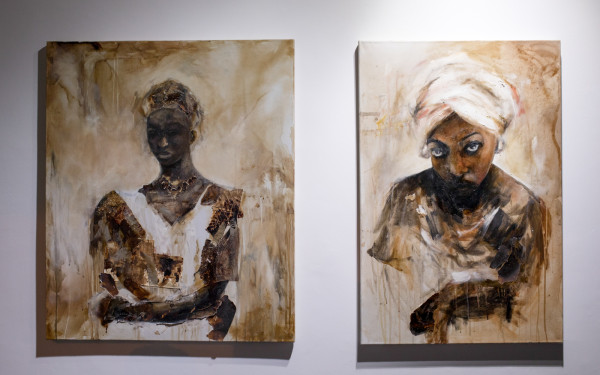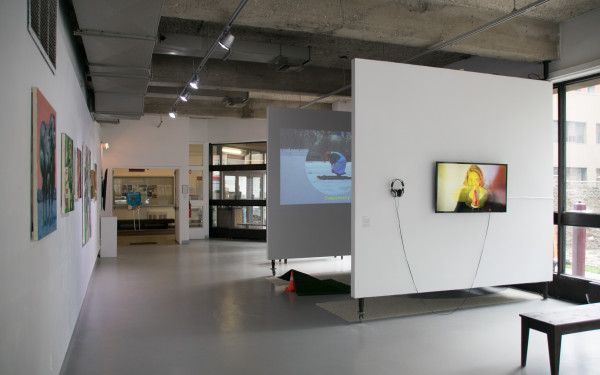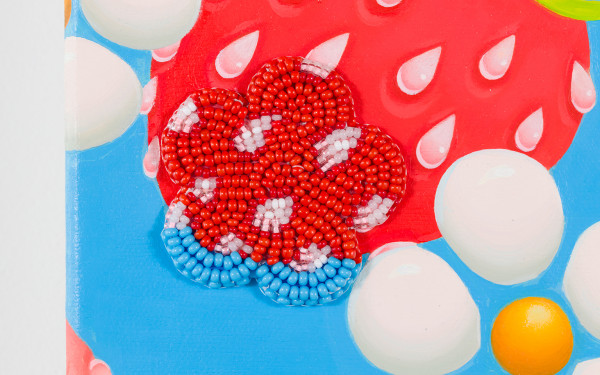The VAV Gallery’s Second Fall Show Features Pieces That Intrigue the Senses
The Art of Appropriation and a Tribute to Brazil’s National Museum Meet in “Corrupted Portal”
“We find ourselves thinking of alternate realities,” reads the blurb for the Visual Arts Visuels Gallery’s current exhibition, Corrupted Portal. “These artists have opened fragile gateways through their pieces.”
Between Oct. 22 and Nov. 9, the student-run gallery will showcase the work of ten Concordia students. Corrupted Portal, the second exhibition of their fall cycle, stands out for the complexity of the art displayed. Ranging from painting and sculpture to video work, the show is colourful and catches the eye.
Painting and drawing student Juliana Delgado offers one of the strongest pieces conceptually, said Jose Garcia, the VAV’s financial and administrative coordinator. Delgado’s untitled sculpture surprises the senses; above the small, cement robed human figure, a sign invites the audience to smell the artwork.
“I wanted to have a vessel that would carry a perfume that would be the main artwork,” said Delgado. “Cement was really reminiscent of the National Museum in Brazil that was made partially out cement. I wanted to combine almost the body of the museum with the smell that it generated when it burnt.”
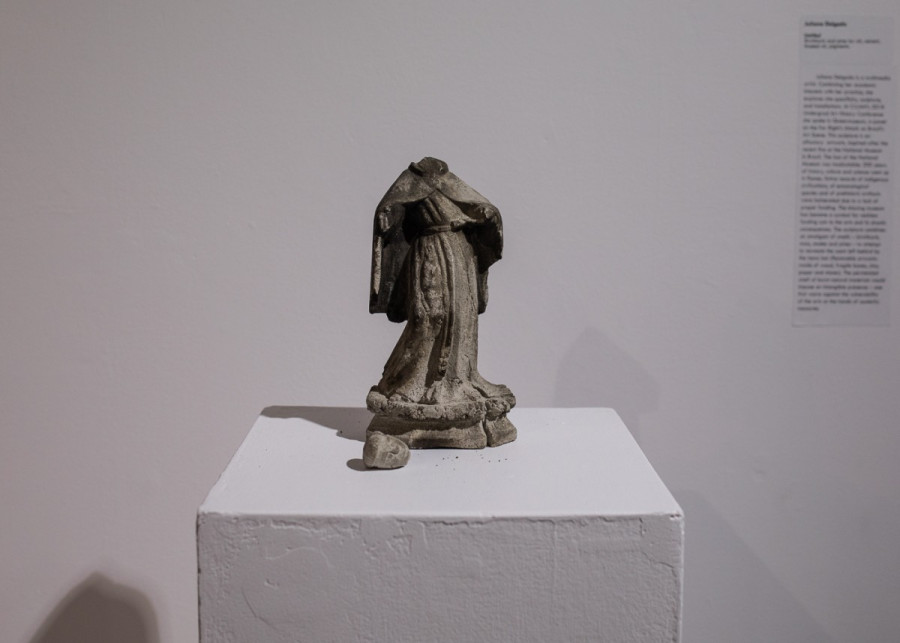
On Sept. 2, a fire devastated Rio de Janeiro’s National Museum, destroying the majority of their artifacts. Delgado, a Brazilian-Canadian artist, started working on her project upon hearing the news at the beginning of the fall semester.
“A lot of the artworks that were in the museum were of anthropological nature, so a lot of bones, fossils, insects, plants, sculptures that were pre-colonial; a lot of stone⎯there was a meteor inside of the museum,” Delgado explained. “So, I wanted to work with [the question]: What would that smell, smell like? What would that burnt smell, smell like? So, I went from that to using ingredients (…) I would find in nature that would kind of replicate the smell.”
Related: The VAV Gallery’s Relics.jpeg Exhibition Focuses on Materials and Aesthetics
Related: The VAV Gallery Exhibition Built Around the Theme of Home
To create the perfume replicating the smell of burning, Delgado began with making tar oil from birch barks, pine leaves and branches, moss, and grass. The filtering process to create the oil was quite laborious, she explained, and required many steps. The first was to dig into the ground and place a ceramic pot. It would act as a recipient to collect the resulting liquid.
Then, she inserted a second ceramic pot which had a hole at the bottom. Inside the second pot was placed a tin can containing the ingredients, and also had a hole at the bottom. Using coal, she set the branches and leaves assortment on fire. The mixture cooked and drained to the bottom, Delgado explained.
To create the smell she desired, she diluted the tar oil with linseed oil and added tobacco and salt. Then she applied the final perfume to the sculpture. She explained that she casted the cement piece from a wooden sculpture of Saint Nicholas that her family has owned for years.
“He is holding a book, and I found it really poignant that whenever I would cast him, his head would break off,” said Delgado. “And I really like the idea that he’s been decapitated, that something has cut him from his life, that was resonant with the museum being cut.”
Studio arts student Gabriel Moreau also went through many steps to create the two acrylic paintings as part of Corrupted Portal. Both Cruel Professor Studying Romances and What’s Your Favorite Collar? originally come from stills from the British video series “Don’t Hug Me, I’m Scared.”
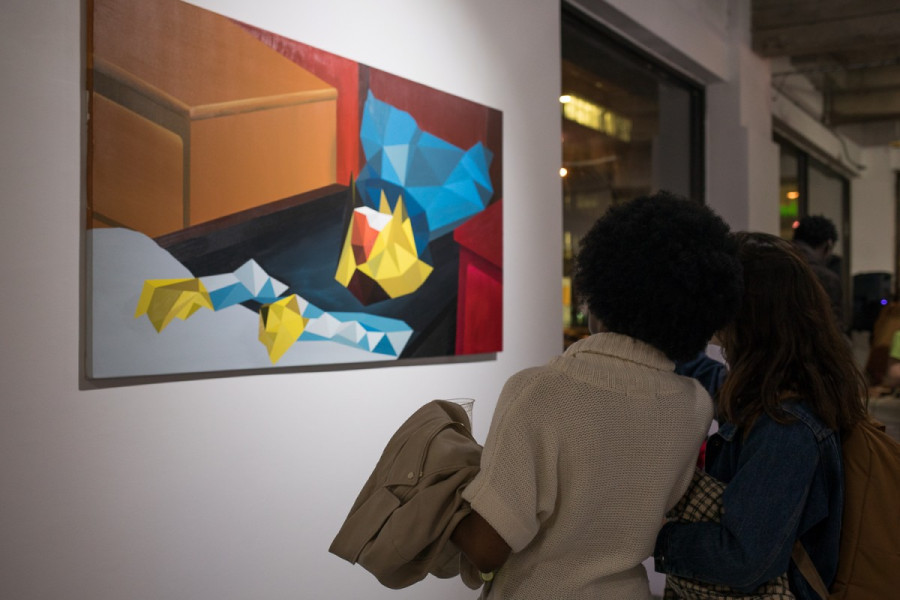
“It is appropriation, it’s the bare bone, conceptually,” said Moreau. “I assume it. I know it is appropriation, but I handle it well, because the important part is the recontextualization. I got inspired from the composition; I got inspired from how the elements together created a kind of scene for me to decipher.”
The characters in his paintings come from the videos. He explained that he digitally cropped them out, deconstructed them into triangles and reconstructed them onto canvases. Moreau used the hard edge painting technique for the two artworks exhibited.
“Hard edge [is] a technique in painting where you put down tape, [and] ideally you seal it with a transparent medium,” explained Moreau. “You put down your layers of paint, ideally two or three. Then you wait for it to dry and you remove the tape. So, it’s a long, intricate way of putting down paint.”
The resulting effect makes for a complex painting generating multiple interpretations. The symbolism of his pieces come to him after finished them, said Moreau. There is no one way is seeing his work, he explained; he believes that every interpretation is equally valid.
After completing What’s Your Favorite Collar?, where a character appears to be in a bedroom drowning in matter, Moreau said he saw the intensity of his anxiety and his difficulty to fall asleep in the painting. He pointed out that others interpret the artwork differently, such as a seeing the painting’s abstract character as a superhero.
“[…] Right now I’m feeling amazing, I’m feeling great,” Moreau said. “I haven’t had any anxiety since that time, it was maybe two years ago. Maybe it is a superhero now, maybe he has a cape. Maybe he has gone further than drowning in his own bed.”
Visit the VAV’s website for information about their next exhibition, Hyper Real: Black History Month in November at the VAV. The vernissage, a free event, will happen on Nov. 15, between 6 p.m. and 8 p.m.
Correction: A previous iteration of this article stated that Juliana Delgado is Brazilian. In fact, she is Brazilian-Canadian. The Link regrets this error.


_600_832_s.png)

